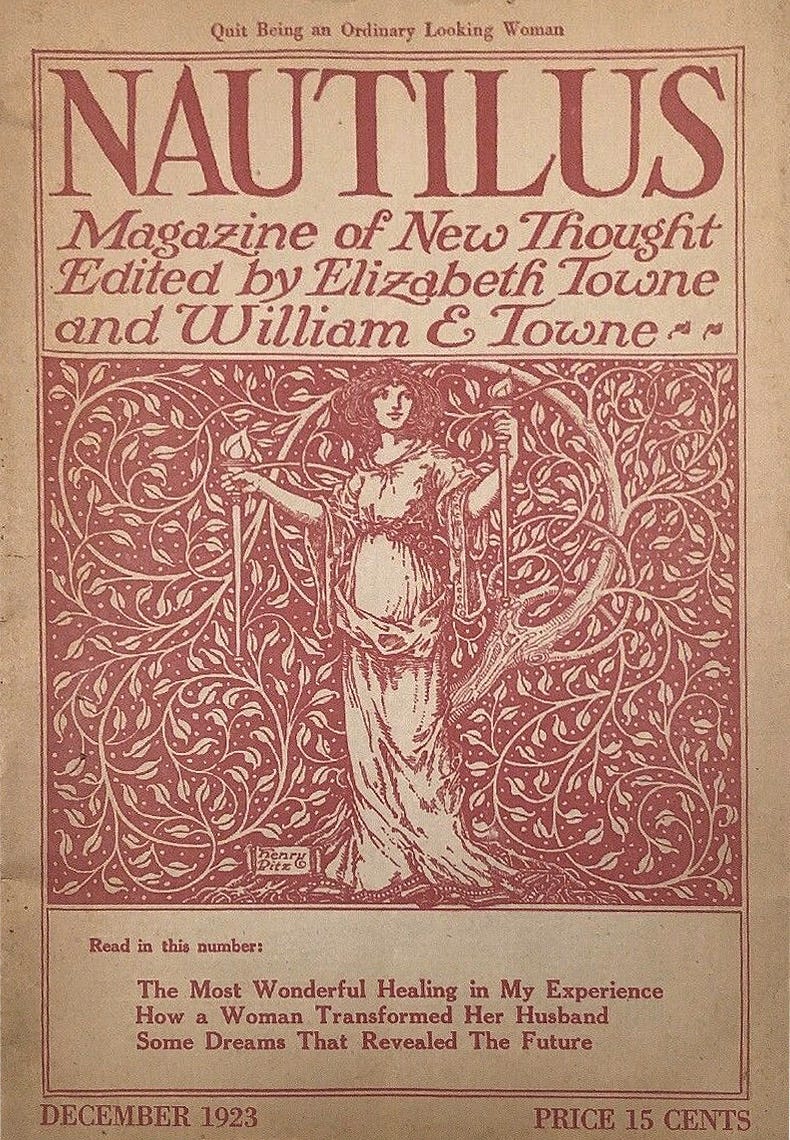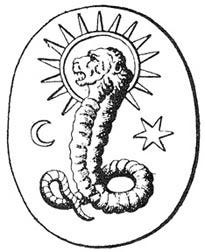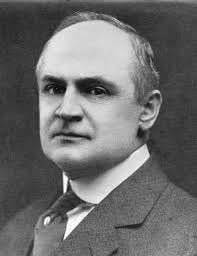When you search the WWW for [hermeticism]1, you will likely see a result page that looks like this…
Across search engines and online bookstores, even the most educated of people will clearly note that the three to four millennia-long Hellenic/Indo-Iranic traditions that are now collectively known as Hermeticism in western civilization is, at its core, composed of seven characteristics.
But this is simply not the case.
Why then? Or better, how did this association of “seven principles” and Hermeticism come about?
A book.
A book written by a merchant and book publisher named William Walker Atkinson, who wrote several books himself under pen names like Theron Q. Dumont, Yogi Ramacharaka, and The Three Initiates.
But we’ll get to him in a minute. What Atkinson based his most infamous book on was the early 19th-century American spiritual movement known as New Thought.

The New Thought movement is a philosophical and spiritual movement that emerged in the 19th and early 20th centuries. It was the liberal offshoot of the Christian Science movement since it was less authoritarian. But at its core, it was part of the metaphysical family of Protestant Christian revivalism.
In this context, the term "metaphysical" refers to the philosophical belief in the primacy of the mental world. Adherents believed that material phenomena resulted from mental states and that the ultimate cause of everything was a divine force, referred to as Divine Mind, Truth, God, Love, Life, Spirit, Principle, or Father-Mother. This belief was influenced by various philosophical and spiritual traditions, including Plato, Hinduism, Berkeley, Hegel, Swedenborg, and transcendentalism. The New Thought movement, also known as the Mind-Cure movement, focused heavily on healing and believed that illness was caused by a lack of "right thinking" or disconnection from the Divine Mind.
The movement traces its origins to Phineas Quimby, an American clockmaker, and mesmerist whose motto was "the truth is the cure." He believed that negative thoughts caused illness and that the mind, guided by the Abrahamic god's wisdom, could overcome any illness. Quimby's ideas were later influenced by the "Mental Science" of Warren Felt Evans, a Swedenborgian minister.
Mary Baker Eddy, the founder of Christian Science, was a patient of Quimby's and was influenced by his ideas, although Christian Science differs from New Thought in some significant ways. Eddy saw her beliefs as a unique and final revelation and introduced the concept of malicious animal magnetism, or the idea that the negative thoughts of others can harm people. Additionally, she rejected the material world as an illusion, rather than just as subordinate to the mind, and therefore rejected the use of medicine in Christian Science, making it the most controversial of the metaphysical groups.
Many of the early leaders and practitioners of New Thought were women, including Emma Curtis Hopkins, Myrtle Fillmore, Malinda Cramer, and Nona L. Brooks, and it’s women who continue to play a significant role in the movement today.
Key Ideas of the New Thought Movement
One of the key ideas of the New Thought movement is the law of attraction, which holds that the mind has the power to attract and manifest the things we desire.
That’s right. The Secret. As in Rhonda Byrne’s 2006 self-help blockbuster. That global New-Age movement was entirely based on the New Thought idea—the law of attraction. The idea is that laws govern the universe and that by focusing human thoughts and feelings on what is wanted, what is wanted will manifest.
Another central tenet of the New Thought movement is the power of positive thinking. Our thoughts and attitudes have a powerful influence on our lives and can shape our experiences for better or for worse. New Thought proponents argue that by maintaining a positive outlook and focusing on the good things in life, we can create a more fulfilling and rewarding experience for ourselves.
Although this tenet seems innocuous, it is also the basis for organizations that developed through the New Thought movement, like Religious Science, Divine Science, and Unity Church. As mentioned above, these groups, along with New Thought adherents, believed that illness was ONLY the failure to realize that the Abrahamic god is the sole and entirety of reality. So to heal, one must affirm their connectedness with…god. That’s all. Medicine? Technology? Rubbish. Children with cancer simply haven’t accepted Jesus into their life.
That’s right (he said, with a look of disgust). Does it get more vile and misguided than this?
Just to note a few things about Christian Science: first, the science of Christian Science is spiritual healing, and second, Christian Scientists helped create religious expectations for medical-neglect laws [Dorothy Sheridan involuntary manslaughter] . In fact, you may be devastated to learn that...
…34 American states offer a legal shield for parents who refuse medical treatment for children on religious grounds, including California!
In addition to these core ideas, the New Thought movement has emphasized the importance of personal growth and self-improvement. New Thought proponents argue that by developing our minds and spirits, we can achieve greater happiness and fulfillment in our lives. This emphasis on personal growth has led to the development of several practices and techniques designed to help individuals achieve their goals and realize their full potential, including affirmations, visualization, and meditation.
Despite its popularity and influence, the New Thought movement has not been without controversy. Many critics have challenged the scientific validity of its ideas, arguing that there is little empirical evidence to support its claims about the power of the mind to shape reality. Others have pointed out that the movement has often been appropriated by more mainstream spiritual and self-help movements, leading to a dilution of its more radical and transformative ideas.
Despite these criticisms, however, the New Thought movement remains an important part of the American spiritual and philosophical landscape. Its ideas about the power of the mind to shape reality and create the lives we desire continue to inspire and influence many people worldwide.
William Walker Atkinson
William Walker Atkinson was a leading figure in the New Thought movement. Born in Baltimore, Maryland, in 1862, Atkinson began his career as a lawyer before turning to the study of metaphysics and the occult. He is best known for his work as a writer and speaker on New Thought topics such as mind power, the law of attraction, and the power of positive thinking.
Atkinson viewed the New Thought movement as one that sought to provide a spiritual and philosophical framework for understanding the nature of reality and the role of the individual in creating their own experience. He believed in the power of positive thinking, arguing that our thoughts and attitudes have a powerful influence on our lives and can shape our experiences for better or worse. By maintaining a positive outlook and focusing on the good things in life, we can create a more fulfilling and rewarding experience for ourselves.
In addition to his work as a writer and speaker, Atkinson was also a prolific publisher, producing many books and articles on metaphysics and the occult. Some of his most well-known works include "The Law of Success," "The Science of Getting Rich," and "Thought Vibration or the Law of Attraction in the Thought World." These works, along with his lectures and seminars, helped to spread the ideas of the New Thought movement to a broader audience and contributed to its growth and popularity.
But his most successful book was one that he penned anonymously—The Kybalion.
The Three Initiates
The Kybalion is a book by “Three Initiates”, a nom de plum for Atkinson. It was first published in 1908. It is a collection of teachings of the New Thought movement, guised as the teachings and principles of Hermeticism—a philosophical and spiritual tradition that originated in ancient Egypt and Greece. Some have considered the Kybalion a classic text in American metaphysics and contend it has had a significant influence on the development of the New Thought movement.
The origins of Hermeticism can be traced back to ancient Egypt, where it was associated with the teachings of the god Thoth and the practice of alchemy. The tradition was later adopted and developed by the Hellenes, who incorporated elements of it into their own Greek, Assyrian, Armenian, Arabic, and Jewish philosophical and spiritual beliefs. Hermeticism emphasizes the importance of understanding the nature of reality and the role of the individual in creating their own experience, and it incorporates a variety of spiritual and philosophical ideas, including elements of Gnosticism, Neoplatonism, and Kabbalah.

The Kybalion is organized around seven core “Hermetic” (a.k.a. New Thought) ideas, expressed as the foundational principles of the universe:
The principle of mentalism states that the mind is the primary force in the universe and that everything is a manifestation of thought.
The principle of correspondence holds that there is a correspondence between the physical and the spiritual realms and that the same laws apply to both.
The principle of vibration suggests that everything in the universe is in a state of vibration and that different vibrations correspond to different qualities or characteristics.
The principle of polarity states that everything in the universe has opposing qualities or aspects and that these opposing forces are interconnected and interdependent.
The principle of rhythm asserts that everything in the universe operates in cycles and patterns and that these rhythms can be observed and understood.
The principle of cause and effect asserts that every action has an equal and opposite reaction and that everything in the universe is connected and interdependent.
The principle of gender posits that everything in the universe has masculine and feminine qualities and that these qualities are in balance and harmony.
Each of these principles is described in detail in the book, focusing on how they relate to the nature of reality and the role of the individual in creating their own experience.
One of the key themes of The Kybalion is the idea that the mind has the power to shape and transform reality. The principle of mentalism, for example, states that "all is mind" and that the mind is the source of all things. This principle is closely related to the law of attraction, the central tenet of the New Thought movement.
Other key themes of The Kybalion include the idea that universal laws govern the universe and that these laws can be understood and harnessed by individuals to create the lives they desire. The principle of correspondence, for example, states that "as above, so below" and that there is a correspondence between the microcosm and the macrocosm. This principle is often interpreted as meaning that the individual has the power to shape their reality by aligning their thoughts and actions with the universal laws that govern the universe. It is also the primary conception of Hermetic thought.
But is The Kybalion actually a Hermetic text? Next time, on The Dottore Chronicles…
These brackets I use as a convention to denote potential search terms.






